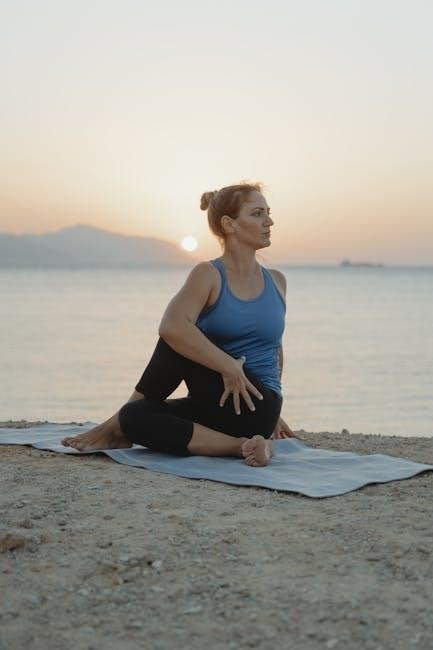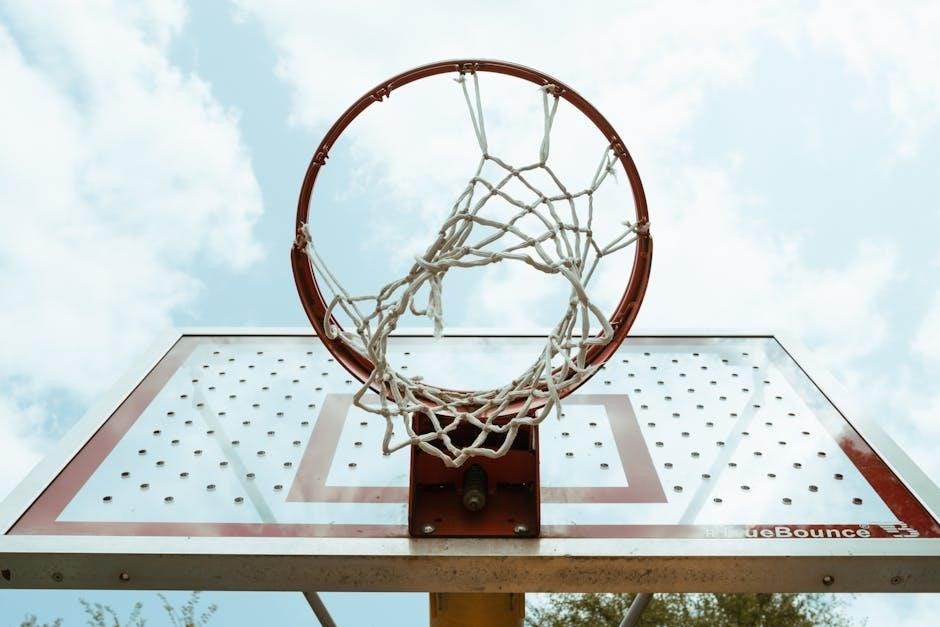Torn rotator cuff exercises are essential for restoring shoulder mobility and strength, aiding in recovery by targeting specific muscles to improve stability and function.
1.1 What is a Torn Rotator Cuff?
A torn rotator cuff is a condition where one or more tendons in the shoulder’s rotator cuff group are partially or completely detached from the bone. These tendons, along with their associated muscles, are crucial for arm movement and shoulder stability. The injury can result from sudden trauma, such as a fall, or gradual wear and tear due to aging or repetitive overhead activities. Symptoms often include persistent shoulder pain, weakness, and limited mobility, impacting daily activities and quality of life.
1.2 Importance of Exercises in Recovery
Exercises play a vital role in recovering from a torn rotator cuff by promoting healing, improving mobility, and strengthening the surrounding muscles. They help restore shoulder function, reduce pain, and prevent further injury. Regular exercises can often avoid the need for surgery by enhancing stability and flexibility. A structured program focusing on stretching and strengthening is key to rebuilding the rotator cuff’s integrity and ensuring long-term recovery. Proper form and consistency are essential for optimal results.
Causes and Symptoms of a Torn Rotator Cuff
A torn rotator cuff often results from acute injuries, such as falls, or gradual degeneration. Symptoms include persistent shoulder pain, weakness, and limited arm mobility.
2.1 Common Causes of Rotator Cuff Tears
Rotator cuff tears often stem from acute injuries, such as falls onto the shoulder or arm, or repetitive overhead movements. Degenerative changes due to aging, heavy lifting, and sports involving overhead activities also contribute. Over time, tendons weaken, making them prone to partial or complete tears. Activities requiring consistent shoulder motion, like baseball or construction work, increase the risk. Early identification of these causes is crucial for effective treatment and recovery.
2.2 Identifying Symptoms of a Torn Rotator Cuff
Symptoms of a torn rotator cuff include persistent shoulder pain, especially at night, and weakness when lifting or rotating the arm. Limited mobility, such as difficulty raising the arm, is common. A deep ache or nagging discomfort may persist, even at rest. Pain worsens with overhead activities or repetitive motions. Some individuals experience a snapping or cracking sensation in the shoulder, while others may feel instability or difficulty performing daily tasks.

Types of Exercises for a Torn Rotator Cuff
Various exercises help recovery, including stretching for mobility, strengthening to build muscle, low-impact activities to manage pain, and isometric exercises for early healing.
3.1 Stretching Exercises for Shoulder Mobility
Stretching exercises are crucial for improving shoulder flexibility and range of motion. Techniques like cross-body stretches, arm circles, and side stretches help reduce stiffness and enhance mobility, making daily activities easier. These exercises target the rotator cuff muscles and surrounding tissues, promoting healing without overexertion. Regular stretching can also prevent further injury by maintaining joint stability and muscle balance. Consistency is key to achieving long-term benefits and restoring normal shoulder function.
3.2 Strengthening Exercises for Rotator Cuff Muscles
Strengthening exercises target the rotator cuff muscles to rebuild resilience and endurance. Techniques include resistance band exercises, light weight training, and specific movements like shoulder blade squeezes. These exercises help restore muscle balance, improving joint stability and reducing pain. Gentle, controlled movements are essential to avoid further injury. Over time, these exercises enhance overall shoulder function, enabling better mobility and strength for daily activities and sports.
3.3 Low-Impact Activities for Pain Management
Low-impact activities such as swimming, cycling, and gentle yoga can help manage pain without exacerbating the injury. These exercises promote blood flow and maintain shoulder mobility while minimizing stress on the rotator cuff. Water-based exercises are particularly beneficial as they reduce gravitational strain. Incorporating these activities into a daily routine can aid in pain relief and support the healing process without risking further damage to the torn tissues.
3.4 Isometric Exercises for Early Recovery
Isometric exercises are crucial for early recovery as they strengthen muscles without joint movement, reducing strain on the torn rotator cuff. Examples include wall slides and shoulder blade squeezes, which promote stability and strength. These exercises help maintain muscle function and prevent atrophy while minimizing pain. Performing them with proper form ensures safety and effectiveness, avoiding further injury during the healing process.

When to Avoid Certain Exercises
Certain exercises, like heavy lifting or overhead movements, should be avoided to prevent worsening the injury, especially if pain persists or symptoms don’t improve with treatment.
4.1 Exercises That May Worsen the Injury
Exercises involving heavy lifting, overhead movements, or repetitive strain can exacerbate a torn rotator cuff. Activities like bench pressing, overhead reaches, or high-impact sports may increase pain and delay recovery. Avoiding these movements helps prevent further damage to the tendons and muscles, allowing the shoulder to heal properly. It’s crucial to focus on low-impact exercises that strengthen without strain.
4.2 Understanding Proper Form and Technique
Proper form and technique are vital when performing exercises for a torn rotator cuff. Incorrect movements can strain the shoulder, worsening the injury. It’s important to maintain controlled, slow motions and avoid jerky actions. Using correct posture and engaging core muscles can help stabilize the shoulder during exercises. Guidance from a physical therapist ensures that each movement is executed safely, promoting effective healing without further damage to the tendons.

Progressive Exercises for Healing
Progressive exercises gradually increase intensity, supporting the healing process without overexertion, and are tailored to the injury’s severity and individual recovery needs.
5.1 Phase 1: Immediate Post-Injury Exercises
Phase 1 focuses on pain management and basic mobility. Gentle exercises like shoulder shrugs, wall slides, and passive rotations are introduced to maintain range of motion without exacerbating the injury. These exercises are low-intensity and designed to promote healing while minimizing strain on the torn tendons. Rest and ice therapy are also emphasized to reduce inflammation and prevent further damage during the initial recovery period.
5.2 Phase 2: Intermediate Strengthening
Phase 2 introduces controlled strengthening exercises to rebuild muscle endurance and stability. Activities like shoulder blade squeezes, light resistance band exercises, and modified planks target the rotator cuff muscles and surrounding areas. These exercises are designed to gradually increase strength without overloading the injured tendon. Proper form and supervision are crucial to ensure progress and prevent re-injury during this phase of rehabilitation.
5.3 Phase 3: Advanced Rehabilitation
Phase 3 focuses on restoring full shoulder function with dynamic exercises and functional movements. Activities include resistance bands, plyometric drills, and sport-specific motions to enhance power and coordination. Patients progress to unrestricted range-of-motion exercises and weight-bearing tasks, improving joint stability and muscle balance. This phase aims to return individuals to their normal activities or athletic pursuits, ensuring long-term strength and injury prevention through consistent practice and proper technique.

Creating a Daily Exercise Routine
A daily routine should balance stretching, strengthening, and rest to promote healing without overexertion, ensuring consistency and gradual progression in recovery.
6.1 Structuring a Balanced Workout Plan
A balanced workout plan for a torn rotator cuff should include a mix of gentle stretching, strengthening exercises, and low-impact activities. Start with pain-free movements like shoulder rolls and wall slides to improve mobility. Gradually incorporate resistance bands or light weights for strength, focusing on exercises like external rotations and scapular squeezes. Avoid high-impact activities that strain the shoulder. Consistency is key, with 2-3 sessions per week, allowing rest days for recovery. Always prioritize proper form to prevent further injury and promote healing.
6.2 Incorporating Rest and Recovery
Rest and recovery are crucial for healing a torn rotator cuff. Overexertion can worsen the injury, so it’s important to balance activity with periods of rest. Use ice packs to reduce inflammation and alleviate pain. Ensure adequate sleep, as it aids in muscle repair. Avoid activities that cause discomfort, especially overhead movements or heavy lifting. Incorporate rest days between workout sessions to allow tissues to heal. Proper recovery supports the effectiveness of exercises and prevents re-injury.

Role of Physical Therapy
Physical therapy plays a vital role in torn rotator cuff recovery, offering personalized exercise programs to restore strength, mobility, and function while reducing pain and preventing further injury.
7.1 Benefits of Professional Guidance
Professional guidance from a physical therapist provides personalized treatment plans tailored to individual recovery needs, ensuring safe and effective progression through exercises. They address specific weaknesses, improve posture, and enhance joint stability, reducing the risk of re-injury. Therapists also educate patients on proper techniques and pain management strategies, promoting long-term shoulder health and functionality. This expertise accelerates recovery and helps restore optimal shoulder movement and strength.
7.2 Customized Exercise Programs
Customized exercise programs for a torn rotator cuff are designed to address individual needs, focusing on specific muscle groups and recovery stages. These tailored plans incorporate stretching, strengthening, and low-impact activities to promote healing without overstrain. By progressing gradually, they help restore shoulder mobility and strength, reducing pain and improving function. Personalized programs ensure each patient follows a structured path to recovery, adapting exercises as healing progresses, and are often developed in consultation with physical therapists.

Surgical Intervention and Post-Op Exercises
Surgical intervention for a torn rotator cuff may involve arthroscopic or open repair. Post-operative exercises focus on gentle movements to restore shoulder function and strength gradually.
8.1 When Surgery is Necessary
Surgery is typically recommended for complete rotator cuff tears, especially when conservative treatments fail. Factors like tear size, symptoms severity, and impact on daily life are considered. Patients with significant weakness or persistent pain despite therapy may benefit from surgical intervention to repair the tendon and restore shoulder function. Arthroscopic procedures are common, offering minimally invasive options for recovery.
8.2 Post-Surgical Rehabilitation Exercises
Post-surgical rehabilitation involves a structured exercise program to restore shoulder strength and mobility. Immediately after surgery, patients focus on passive exercises, like gentle arm rotations, to avoid stressing the repair. Around 6-8 weeks, active exercises begin, incorporating resistance bands and light weights. By 3-4 months, patients progress to dynamic strengthening to rebuild muscle function. Proper adherence to these exercises, often guided by a physical therapist, is crucial for successful healing and preventing re-injury.
A consistent exercise regimen, combined with proper guidance, is key to effectively managing and recovering from a torn rotator cuff, ensuring restored shoulder function and strength.
9.1 Summary of Key Points
Torn rotator cuff exercises are crucial for recovery, focusing on stretching, strengthening, and mobility. Early recovery involves isometric exercises, while progressive phases include intermediate and advanced rehabilitation. Proper form and avoiding aggravating activities are essential. Physical therapy provides personalized programs, enhancing recovery. Surgery may be necessary for severe tears, followed by post-operative exercises. Consistency and professional guidance are vital for restoring shoulder function and preventing re-injury, ensuring a successful and sustainable recovery process.
9.2 Final Tips for Successful Recovery
Consistency is key to successful recovery; adhere to your exercise routine and incorporate rest to avoid overexertion. Prioritize proper form and technique to prevent further injury. Monitor progress and adjust exercises as strength improves. Avoid heavy lifting or repetitive overhead movements during healing. Seek professional guidance if pain persists or recovery stalls. Patience and dedication are crucial, as full recovery may take time. Combining these strategies ensures optimal healing and restores shoulder function effectively.